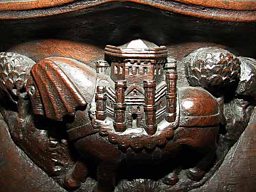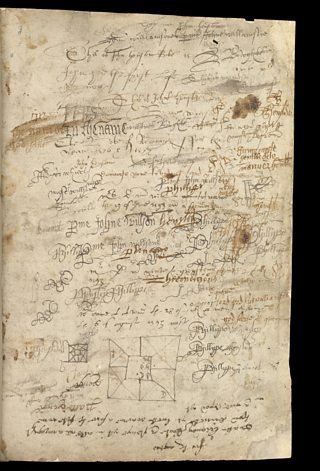Lancashire family prove pivotal to Shakespeare's players
A Lancashire family proved pivotal to the success of Shakespeare’s early performing years.
The Stanleys, with their vast residences near Ormskirk in Lancashire and at Knowsley near Liverpool, were enthusiastic sponsors of Elizabethan entertainers.
-
![]()
Much Ado near me
Hear more Shakespeare stories on BBC Radio Lancashire
-
![]()
Shakespeare Festival 2016
The BBC celebrates the genius of the bard

Ferdinando Stanley, born around 1559, was the eldest son and heir of Henry Stanley, 4th Earl of Derby. He assumed the title of Lord Strange in his early teens and became the 5th Earl of Derby only briefly, from 25 September 1593 until his premature death – under mysterious circumstances on 16 April 1594.
Ferdinando’s ancestors, as well as his father, had a long history of patronising entertainers and he was no exception.
Ferdinando’s ancestors, as well as his father, had a long history of patronising entertainers and he was no exception. As a teenager he adopted patronage of his first troupe, which toured the provinces and played at court, with acrobatic skills that won them high rewards.
By the later 1580s, as he pursued his career at Court, Ferdinando was looking again to sponsor a troupe in his name, at a time soon after the death of his mentor, the powerful Earl of Leicester, Robert Dudley.
Leicester’s troupe included at the time George Bryan, Will Kemp, and Thomas Pope. And it is they who then surface in documentary evidence as Strange’s Men in 1593 and then as Chamberlain’s Men with Shakespeare in 1594.
Linking Lord Strange's Men to Shakespeare
Lord Strange’s (pronounced strang) first troupe of performers specialised in acrobatic acts.

It is clear from these brief accounts that the family regularly enjoyed performances by their players during the Christmas and Shrovetide seasons when at home.
It was in the late 1580s and early 1590s that the Lord Strange’s Men were to make their mark, as they set their sights on success in London…and the new Rose Theatre.
The Rose playhouse was erected in 1587 and became the first purpose-built theatre south of the Thames to be located on Bankside, Southwark.
The first acting company known to have been in residence at the Rose was Lord Strange’s Men, who had won themselves a reputation as an innovative and talented troupe under the patronage of Ferdinando Stanley.
There is some agreement among academics and historians that Shakespeare may have joined Lord Strange’s Men by 1592, and among the first of Shakespeare’s plays to be performed was probably Henry VI Part 1. (According to theatre manager and owner Philip Henslowe, who kept a diary during this time, in the four months around spring 1592, a new play in the repertoire of Lord Strange's Men was harey the vj, (Henry VI))
In 1592, when Henry VI Part I was mounted at the Rose, Strange’s men were forced to go on a provincial tour during the closure of the theatres, first as result of an apprentices’ riot in Southwark in June that drew the ire of the Privy Council, and then as plague became endemic in the city of London later the same summer. They were able to return to the Rose by December 1592 but then the theatres were closed again because of plague in 1593 for a long period, which explains why Strange's men did not perform at the Rose after 1 February 1593.
Records show that "my Lordes stranges players" went on to tour and, among other venues, were paid 20 shillings in Maidstone, Kent.
Although we cannot say for certain whether Shakespeare joined the tour, leading academics such as Sally-Beth MacLean, from Records of Early English Drama (REED) say there's a good chance that his play Henry VI, pt 1, was probably in the touring repertory.
Lord Strange’s Men changed their name to Derby’s Men because their patron Lord Strange, assumed the title when his father died. Actors including William Kemp (sometimes spelled with and without an 'e' and was to go on to become Shakespeare’s ‘clown’); Thomas Pope and George Bryan.
Will Kemp, Thomas Pope and George Bryan, the three leading members of Strange’s men, migrated to join Shakespeare and Richard Burbage in the newly formed Chamberlain’s Men after the sudden death of their patron, Ferdinando Stanley in the spring of 1594.
All three would have been known to Shakespeare already, at least as actors in Henry VI, Part I during their heyday with Strange’s men.
This Northern connection is still in evidence years later, when in 1614 - Shakespeare is still alive and retired to Stratford on Avon by this time – the Bard’s company, now known as the King’s Men, return to the North West to perform alongside the Earl of Derby’s troupe in a Cheshire Inn.
Lathom - Principal house of the Stanleys
Situated two miles from Ormskirk, not far from the main road north, Lathom was the principal house of the Stanleys from the late 15th c. until it was besieged and taken by parliamentary forces during the Civil War (large portions were dismantled in 1646).
A fortified castle, Lathom seems to have had a number of towers, which accounts give variously as seven, nine or 11 in number:
'The building itself was of vast extent, with a massive keep -- the Eagle Tower -- rising in the midst, and surrounded by embattled curtain walls, strengthened by seven lofty towers, the whole being encircled by a wide ditch or moat, across which access was gained by a drawbridge communicating with a portcullised gateway' (Croston, County Families 86).
No trace of the original structure remains and until the late 20th c. excavations the original site was uncertain.
Stanley household accounts survive for only a short time in the later 16th c. (1586--90) when Henry, the 4th Earl, and his family were periodically in residence at their Lancashire houses. It is clear from these brief accounts that the family regularly enjoyed performances by their players during the Christmas and Shrovetide seasons when at home. There is evidence from the accounts that Lord Strange’s Men visited both Lathom and Knowsley between 1587 and 1590 for festive celebrations.
Shakespeare on Tour
From the moment they were written through to the present day, Shakespeare’s plays have continued to enthral and inspire audiences. They’ve been performed in venues big and small – including inns, private houses and emerging provincial theatres.

BBC English Regions is building a digital picture which tracks some of the many iconic moments across the country as we follow the ‘explosion’ in the performance of The Bard’s plays, from his own lifetime to recent times.
Drawing on fascinating new research from Records of Early English Drama (REED), plus the British Library's extensive collection of playbills, as well as expertise from De Montfort University and the Arts and Humanities Research Council, Shakespeare on Tour is a unique timeline of iconic moments of those performances, starting with his own troupe of actors, to highlights from more recent times. Listen out for stories on Shakespeare’s legacy on your BBC Local Radio station from Monday 21 March, 2016.
You never know - you might find evidence of Shakespeare’s footsteps close to home…
Craig Henderson, BBC English Regions
-
![]()
Shakespeare Lives
The nation’s greatest performing arts institutions mark 400 years since the Bard's death
Related Links
Shakespeare on Tour: Around Lancaster
-
![]()
Shakespeare is dead, but his players tour Lancashire
Dunkenhalgh Hall was a frequent stop on the King's Men tour through Lancashire
-
![]()
Lancaster Theatre sparkles with Shakespearean talent
The Grand Theatre in Lancaster, which was once managed by Stephen Kemble
Shakespeare on Tour: Around the country
-
![]()
Ipswich: a magnet for Shakespeare?
Why did Shakespeare's company visit Ipswich ten times?
-
![]()
Sarah Siddons visits Norwich
Putting the Theatre Royal, Norwich, on the map
-
![]()
Madame Tussaud's exhibiton in Nottingham
Including a model of William Shakespeare
-
![]()
Touring Kent to avoid the plague
In 1592, the plague forced touring theatre companies out of London









